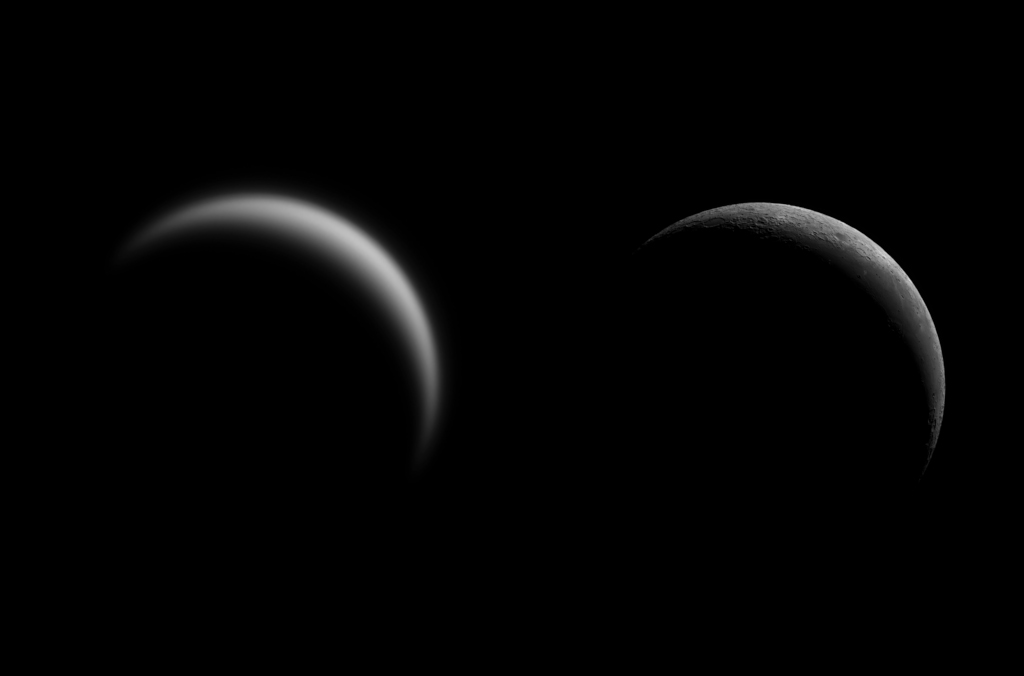03. February 2022
去予太陽光攬牢 ê 金星 kah 月娘

探索宇宙1!逐工會揀一幅無仝款 ê 影像抑是相片,𤆬你熟似咱這个迷人 ê 宇宙,閣有專業天文學者2為你3解說4。
- 原始文章:Embraced by Sunlight
- 影像來源 kah 版權:Juan Luis Cánovas Pérez
- 台文翻譯:An-Li Tsai (NCU)
[漢羅] 去予太陽光攬牢 ê 金星 kah 月娘
倒爿彼粒是 金星,伊是天頂上光 ê 行星。 Tī 1 月 29 這工,伊 ê 視寸尺干焦是月娘 ê 1/30 爾爾。 毋閣 in 若是 tī 日出進前 peh--起來,in 就會看起來攏是 月眉形。 In 若是 tī 東南爿 ê 地平線面頂出現,in 發光 ê 部份就干焦佔盤面 ê 12 葩。 這兩張月眉形 ê 相片, 是去予差不多仝角度 ê 太陽照著 ê。 In 放大 ê 比例無仝,毋閣 in 攏是 ùi 細台望遠鏡翕 ê 影片來 ê,是 kā 影片 ê 影格 疊做一張 ê。 金星看起來 kah 月娘一部份 ê 月相 欲仝,是因為伊是內行星。 伊會 tī 暗頭仔 kah 透早出現,這个變化 ê 週期是 584 工。 是講月娘 完成一个完整 ê 月圓週期是 29 工半。
[POJ] Khì hō͘ Thài-iông-kng lám-tiâu ê Kim-chhiⁿ kah Goe̍h-niû
Tò-pêng hit-lia̍p sī Kim-chhiⁿ, i sī thiⁿ-téng siōng-kng ê kiâⁿ-chhiⁿ. Tī it goe̍h jī-káu chi̍t-kang, i ê sī-chhùn-chhioh kan-na sī goe̍h-niû ê saⁿ-cha̍p-hun-chi-it niā-niā. M̄-koh in nā-sī tī ji̍t-chhut chìn-chêng peh--khí-lâi, in to̍h ē khòaⁿ-khí-lâi lóng-sī goe̍h-bâi-hêng. In nā-sī tī tang-lâm-pêng ê tē-pêng-sòaⁿ bīn-téng chhut-hiān, in hoat-kng ê pō͘-hūn to̍h kan-na chiàm pôaⁿ-bīn ê cha̍p-jī pha. Chit nn̄g-tiuⁿ goe̍h-bâi-hêng ê siòng-phìⁿ, sī khì hō͘ chha-put-to kâng kak-tō͘ ê Thài-iông chiò-tio̍h ê. In hòng-tōa ê pí-lē bô-kâng, m̄-koh in lóng-sī ùi sè-tâi bōng-oán-kiàⁿ hip ê iáⁿ-phìⁿ lâi ê, sī kā iáⁿ-phìⁿ ê iáⁿ-keh tha̍h chò chi̍t-tiuⁿ ê. Kim-chhiⁿ khòaⁿ--khí-lâi kah goe̍h-niû chi̍t-pō͘-hūn ê goe̍h-siòng beh kâng, sī in-ūi i sī lōe-kiâⁿ-chhiⁿ. I ē tī àm-thâu-á kah thàu-chá chhut-hiān, chit-ê piàn-hòa ê chiu-kî sī gō͘-pah-peh-cha̍p-sì kang. Sī-kóng goe̍h-niû oân-sêng chi̍t-ê oân-chéng ê goe̍h-îⁿ-chiu-kî sī jī-cha̍p-káu kang poàn.
[KIP] Khì hōo Thài-iông-kng lám-tiâu ê Kim-tshinn kah Gue̍h-niû
Tò-pîng hit-lia̍p sī Kim-tshinn, i sī thinn-tíng siōng-kng ê kiânn-tshinn. Tī it gue̍h jī-káu tsi̍t-kang, i ê sī-tshùn-tshioh kan-na sī gue̍h-niû ê sann-tsa̍p-hun-tsi-it niā-niā. M̄-koh in nā-sī tī ji̍t-tshut tsìn-tsîng peh--khí-lâi, in to̍h ē khuànn-khí-lâi lóng-sī gue̍h-bâi-hîng. In nā-sī tī tang-lâm-pîng ê tē-pîng-suànn bīn-tíng tshut-hiān, in huat-kng ê pōo-hūn to̍h kan-na tsiàm puânn-bīn ê tsa̍p-jī pha. Tsit nn̄g-tiunn gue̍h-bâi-hîng ê siòng-phìnn, sī khì hōo tsha-put-to kâng kak-tōo ê Thài-iông tsiò-tio̍h ê. In hòng-tuā ê pí-lē bô-kâng, m̄-koh in lóng-sī uì sè-tâi bōng-uán-kiànn hip ê iánn-phìnn lâi ê, sī kā iánn-phìnn ê iánn-keh tha̍h tsò tsi̍t-tiunn ê. Kim-tshinn khuànn--khí-lâi kah gue̍h-niû tsi̍t-pōo-hūn ê gue̍h-siòng beh kâng, sī in-uī i sī luē-kiânn-tshinn. I ē tī àm-thâu-á kah thàu-tsá tshut-hiān, tsit-ê piàn-huà ê tsiu-kî sī gōo-pah-peh-tsa̍p-sì kang. Sī-kóng gue̍h-niû uân-sîng tsi̍t-ê uân-tsíng ê gue̍h-înn-tsiu-kî sī jī-tsa̍p-káu kang puàn.
[English] Embraced by Sunlight
Even though Venus (left) was the brightest planet in the sky it was less than 1/30th the apparent size of the Moon on January 29. But as both rose before the Sun they shared a crescent phase. For a moment their visible disks were each about 12 percent illuminated as they stood above the southeastern horizon. The similar sunlit crescents were captured in these two separate images. Made at different magnifications, each panel is a composite of stacked video frames taken with a small telescope. Venus goes through a range of phases like the Moon as the inner planet wanders from evening sky to morning sky and back again with a period of 584 days. Of course the Moon completes its own cycle of phases, a full lunation, in about 29.5 days.
詞彙學習
| 漢羅 | POJ | KIP | 華語 | English |
|---|---|---|---|---|
| 視寸尺 | sī-chhùn-chhioh | sī-tshùn-tshioh | 視尺寸 | apparent size |
| 月眉形 | goe̍h-bâi-hêng | gue̍h-bâi-hîng | 新月 | a crescent phase |
| 內行星 | lōe-kiâⁿ-chhiⁿ | luē-kiânn-tshinn | 內行星 | inner planet |
| 月圓週期 | goe̍h-îⁿ chiu-kî | gue̍h-înn tsiu-kî | 月圓週期 | lunation |
| 影格 | iáⁿ-keh | iánn-keh | 影格 | video frame |
| 月相 | goe̍h-siòng | gue̍h-siòng | 月相 | moon phase |